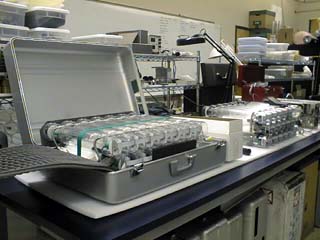10 August, 1998
Monday, August 10, 1998
Boulder local news from " Daily Camera" was this morning: " Boulder
nears limits on bad air"
It says in the news paper today :" .... In June and July, the air in
Boulder, Denver and other sites in the metro are was not parcticular
healthy. There was too much ozone in it Though the gas is good high in
the atmosphere where it prevents damaging radiation from reaching the
planet, at the surface it's a dangerous pollutant that harms people's
lungs"
Imagine what it might have been in other cities of the U.S. much larger
than Denver and Boulder such as New York or L.A.!!
The Daily Camera continues:" And if metro-area cities don't clean up
their air within a few years, the
Environmental Protection Agency could force them to consider restricting
gasoline-powered lawn mowers and automobile emissions or implementing
alternative transportation programs, said Mike Weil, acting director of
environmental affairs for the city of Boulder. ......... Cars and power
plants emit chemicals that, in the presence of heat and light, combine
to form ozone. That synthesis process explains why ozone levels
skyrocketing during June and July's hot, sunny days, and why ozone
levels go up and down throughout the day."
Bryan and I discussed the arcticle and he agreed with the technical
report. Boulder are facing a special problem as well:
" 'But some of the ozone that plagues Boulder is not homegrown, said
Patric Reddy, senior meteorologist with the Colorado Department of
Public Health and Environment. It's from Denver. In the daytime in the
summer, we get upslope winds that are often blowing from the southeast'
".
The paper continues to discuss the values of ozone which I also learned
from Bryan: The new ozone standards ask monitors to pick the
fourth-highest ozone reading of the year and average with the same
figure for the two previous years. The resulting number must be below
0.085ppm (parts per million) and the readings themselves are 8 hour
averages. The previous regulation from EPA required an hourly reading
could only exceed 0.125ppm for 24 hours within any three years.
After hiking and bicycling around Boulder on the weekend , this morning,
I learned coincidentally about the research in the Carbon Cycle Group,
worked more on the Dobson with Andy and with Ian and Bryan on preparing
ozonesondes for our next flight on Thursday. I will report about the
Carbon Cycle Group.
The Carbon Cycle:
Peter Tans is the Group Leader of the Carbon Cycle group. He is
originally from the Netherlands but has been in this country doing
research for over 20 years.
His group is measuring the concentrations of different gases such as
carbon dioxide, methane, carbon monoxide, Hydrogen (H2), Nitrous oxide
(N2O), carbon isotopes C12 and C13, and sulfohexofluoride (SF6) at
different sites throughout the world. His groups goal is to establish
the sources ( areas of source) and sinks (areas of uptake) as a function
of time. In other words: how do the concentrations of these gases change
over the sources and sinks.
The group has different techniques to accomplish the sampling :
* surface bottle sampling
* tower sampling
* Profile sampling using an aircraft, Special bottles are placed
in a special "suit case" on an air craft and a pump is filling the
bottles while the aircraft is rising.
Peter's group is part of the Global Sampling Network and takes
samples from Boulder , Wisconsin, North Carolina other American
stations. Some of the 60 worldwide stations are located in Israel and
South Africa and Mongolia. Some of these are tower stations (i.e.
broadcasting antennas), others are on the surface in deserts. Other
surface samples are taken on the oceans. One surface sample, for
instance, is taken on a passenger ferry going from Poland to Sweden..
It was interesting to discuss the Kyoto Protocol with Peter. It was
signed in December of 97. This international protocol demands the 8%
decrease of the 1990 Carbon dioxide levels by 2008 - 2012.
The U.S.A committed itself so far to a 7% decrease, Japan to a 6%
decrease.
It is not clear yet, however, how this protocol is being enforced.
Should we all start a little bit and burn less fossil fuels?
Check out their web page : http://www.cmdl.noaa.gov/ccg/
The picture show a special "suit case" with air sampling bottles. This
case can be placed on an air plane. While the plane is gaining on
altitude, air samples are taken at different height intervals, providing
a sampling profile. The concentration of gases such as carbon dioxide
can then be measured in the lab.

The picture shows a special "suit case" containing bottles for air samples. This case is placed on an air plane. While the plane is gaining on altitude, air samples are taken at different height intervals, providing a sampling profile. The concentration of gases such as carbon dioxide can then be measured in the lab.
Contact the TEA in the field at
.
If you cannot connect through your browser, copy the
TEA's e-mail address in the "To:" line of
your favorite e-mail package.
|
